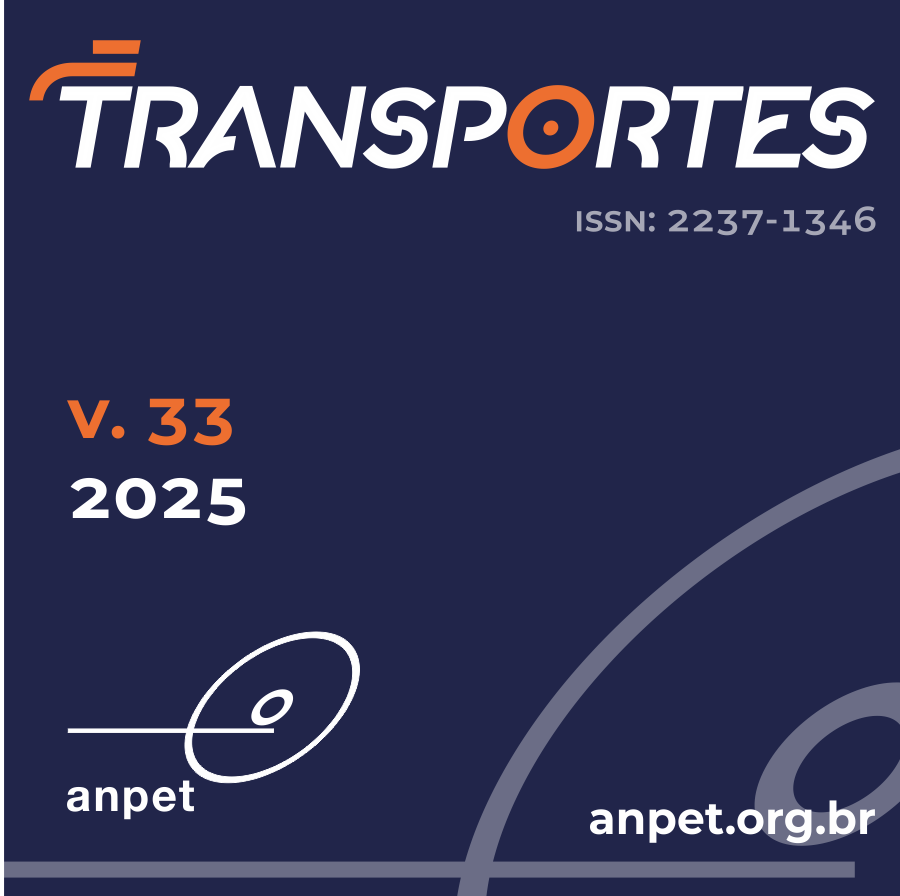Accessibility, mobility and participation in activities in housing complexes in Fortaleza
DOI:
https://doi.org/10.58922/transportes.v33.e3057Keywords:
Urban accessibility. Urban mobility. Socio-spatial inequality. Public housing complexes.Abstract
Given the growing housing demand among low-income populations, public policies have prioritized the construction of public housing complexes in peripheral areas, which are often characterized by limited infrastructure and restricted access to employment and recreational opportunities. This study aims to analyze patterns of accessibility, mobility, and the built environment within these housing developments, using Fortaleza as a case study. The methodology integrates secondary data from multiple sources, including the 2019 household OD survey and applies representative indicators of the analyzed phenomena across five city regions. The findings reveal significant variations in mobility, urban structure, and accessibility across regions, with notable distinctions in the northeastern, southeastern and southwestern portions of the urban territory. These disparities underscore the urgent need for public policies focused on enhancing land use and transport integration, as a means to mitigate the effects of socio-spatial inequalities in accessibility.
Downloads
References
Andrade, B.R.; C.F.G. Loureiro; F.F.L.M. Sousa et al. (2020) Efeitos da periferização nos níveis de acessibilidade aos empregos da população de baixa renda em Fortaleza, Transportes, v. 28, n. 3, p. 46-60. DOI: 10.14295/transportes.v28i3.1810. DOI: https://doi.org/10.14295/transportes.v28i3.1810
Assis, R.F.; C.F.G. Loureiro e F.F.L.M. Sousa (2022) Modelagem LUTI das decisões locacionais de diferentes grupos socioeconômicos: determinantes e inter-relações. urbe. Revista Brasileira de Gestão Urbana, v. 14, e20210395. DOI: 10.1590/2175-3369.014.e20210395. DOI: https://doi.org/10.1590/2175-3369.014.e20210395
Bertolini, L.; F. Le Clercq e L. Kapoen (2005) Sustainable accessibility: a conceptual framework to integrate transport and land use plan-making. Transport Policy, v. 12, n. 3, p. 207-220. DOI: 10.1016/j.tranpol.2005.01.006. DOI: https://doi.org/10.1016/j.tranpol.2005.01.006
Borges, W.A. e M.M. Rocha (2004) A compreensão do processo de periferização urbano do Brasil por meio da mobilidade centrada no trabalho. Geografia, v. 29, n. 3, p. 383-400. Disponível em: <https://www.periodicos.rc.biblioteca.unesp.br/index.php/ageteo/article/view/936/870> (acesso em 30/10/2024).
Braga, C.K.V.; C.F.G. Loureiro e R.H. Pereira (2020) Analisando a variabilidade de estimativas de acessibilidade por transporte público a partir de dados de GPS. Transportes, v. 28, n. 5, p. 169-184. DOI: 10.14295/transportes.v28i5.2175. DOI: https://doi.org/10.14295/transportes.v28i5.2175
Brasil (2018). Portaria nº 660, de 14 de novembro de 2018. Diretrizes para a elaboração de projetos e estabelece as especificações técnicas mínimas da unidade habitacional e as especificações urbanísticas dos empreendimentos destinados à aquisição e alienação com recursos advindos da integralização de cotas no Fundo de Arrendamento Residencial - FAR, e contratação de operações com recursos transferidos ao Fundo de Desenvolvimento Social - FDS, no âmbito do Programa Minha Casa, Minha Vida - PMCMV. Diário Oficial da República Federativa do Brasil. Brasília. Disponível em: <https://www.in.gov.br/web/guest/materia/-/asset_publisher/Kujrw0TZC2Mb/content/id/50484132/do1-2018-11-16-portaria-n-660-de-14-de-novembro-de-2018-50483803> (acesso em 30/10/2024).
Castro, I.R.; C.F.G. Loureiro e M.A. Giannotti (2025) Evolution of accessibility to work for low-income populations in Brazil: towards equitable and sustainable metropolises. Habitat International, v. 156, p. 103306. DOI: 10.1016/j.habitatint.2025.103306. DOI: https://doi.org/10.1016/j.habitatint.2025.103306
Castro, I.R.; M.F. Siqueira; C.K.V. Braga et al. (2024) Acesso às oportunidades na cidade informal: caracterizando o papel da acessibilidade no ambiente construído e na mobilidade em assentamentos precários de Fortaleza. Transportes, v. 32, n. 2, e2891. DOI: 10.58922/transportes.v32i2.2891. DOI: https://doi.org/10.58922/transportes.v32i2.2891
Cervero, R. e K. Kockelman (1997) Travel demand and the 3Ds: density, diversity, and design. Transportation Research Part D, Transport and Environment, v. 2, n. 3, p. 199-219. DOI: 10.1016/S1361-9209(97)00009-6. DOI: https://doi.org/10.1016/S1361-9209(97)00009-6
Ewing, R. e R. Cervero (2001) Travel and the built environment: a synthesis. Transportation Research Record: Journal of the Transportation Research Board, v. 1780, n. 1, p. 87-114. DOI: 10.3141/1780-10. DOI: https://doi.org/10.3141/1780-10
Fortaleza, Prefeitura Municipal, Secretaria Municipal do Desenvolvimento Habitacional – HABITAFOR (2013) PLHIS - Plano Local de Habitação de Interesse Social de Fortaleza: pelo Ingresso à Terra Urbanizada e à Moradia Digna e Sustentável. Produto V. Recife: HABITAFOR.
Freitas, C.S. e L.R.B. Pequeno (2015) Produção habitacional na Região Metropolitana de Fortaleza na década de 2000: avanços e retrocessos. Estudos Urbanos e Regionais, v. 17, n. 1, p. 45-59. DOI: 10.22296/2317-1529.2015v17n1p45. DOI: https://doi.org/10.22296/2317-1529.2015v17n1p45
Geurs, K.T. e B. van Wee (2004) Accessibility evaluation of land-use and transport strategies: review and research directions. Journal of Transport Geography, v. 12, n. 2, p. 127-140. DOI: 10.1016/j.jtrangeo.2003.10.005. DOI: https://doi.org/10.1016/j.jtrangeo.2003.10.005
Guzman, L.A.; D. Oviedo e C. Rivera (2017) Assessing equity in transport accessibility to work and study: the Bogotá region. Journal of Transport Geography, v. 58, p. 236-246. DOI: 10.1016/j.jtrangeo.2016.12.016. DOI: https://doi.org/10.1016/j.jtrangeo.2016.12.016
Hägerstrand, T. (1970) What about people in Regional Science. Papers in Regional Science, v. 24, n. 1, p. 6-21. DOI: 10.1007/BF01936872. DOI: https://doi.org/10.1007/BF01936872
Handy, S. (2005) Smart growth and the transportation-land use connection: what does the research tell us. International Regional Science Review, v. 28, n. 2, p. 146-167. DOI: 10.1177/0160017604273626. DOI: https://doi.org/10.1177/0160017604273626
Hanson, S. (2004). The context of urban travel: concepts and recent trends. In Hanson, S. e G. Giuliano (eds.) The Geography of Urban Transportation (3rd ed.). New York: Guilford Press, p. 3-29.
IBGE (2023) Censo Demográfico 2022: População e Domicílios: Primeiros Resultados. Rio de Janeiro: Coordenação Técnica do Censo Demográfico. Disponível em: <https://biblioteca.ibge.gov.br/visualizacao/livros/liv102011.pdf> (acesso em 29/10/2024)
Kwan, M.P. (1998) Space-time and integral measures of individual accessibility: a comparative analysis using a point-based framework. Geographical Analysis, v. 30, n. 3, p. 191-216. DOI: 10.1111/j.1538-4632.1998.tb00396.x. DOI: https://doi.org/10.1111/j.1538-4632.1998.tb00396.x
Leite, C.C.; M. Giannotti e G. Gonçalves (2022) Social housing and accessibility in Brazil’s unequal cities. Habitat International, v. 127, p. 102628. DOI: 10.1016/j.habitatint.2022.102628. DOI: https://doi.org/10.1016/j.habitatint.2022.102628
Lima, L.S.; C.F.G. Loureiro; F.F.L.M. Sousa et al. (2021) Espraiamento Urbano e seus Impactos nas Desigualdades Socioespaciais da Acessibilidade ao Trabalho em Fortaleza. Transportes, v. 29, n. 1, p. 229-246. DOI: 10.14295/transportes.v29i1.2348. DOI: https://doi.org/10.14295/transportes.v29i1.2348
Lopes, A.S.; C.B. Cavalcante; D.S. Vale et al. (2020) Convergence of planning practices towards LUT integration: Seeking evidences in a developing country. Land Use Policy, v. 99, p. 104842. DOI: 10.1016/j.landusepol.2020.104842. DOI: https://doi.org/10.1016/j.landusepol.2020.104842
Lopes, A.S.; C.F.G. Loureiro and B. van Wee (2019) LUTI operational models review based on the proposition of an a priori ALUTI conceptual model. Transport Reviews, v. 39, n. 2, p. 204-225. DOI: 10.1080/01441647.2018.1442890. DOI: https://doi.org/10.1080/01441647.2018.1442890
Lucas, K. (2012) Transport and social exclusion: where are we now. Transport Policy, v. 20, p. 105-113. DOI: 10.1016/j.tranpol.2012.01.013. DOI: https://doi.org/10.1016/j.tranpol.2012.01.013
Maricato, E. (2003). Metrópole, legislação e desigualdades. Estudos Avançados, v. 17, n. 48, p. 151-167. DOI: 10.1590/S0103-40142003000200013. DOI: https://doi.org/10.1590/S0103-40142003000200013
Maricato, E. (2017) The future of global peripheral cities. Latin American Perspectives, v. 44, n. 2, p. 18-37. DOI: 10.1177/0094582X16685174. DOI: https://doi.org/10.1177/0094582X16685174
Marques, E. e H. Torres (2004) São Paulo: Segregação, Pobreza e Desigualdades Sociais. São Paulo: Ed. SENAC.
Martínez, C.F.; F. Hodgson; C. Mullen et al. (2018) Creating inequality in accessibility: The relationships between public transport and social housing policy in deprived areas of Santiago de Chile. Journal of Transport Geography, v. 67, p. 102-109. DOI: 10.1016/j.jtrangeo.2017.09.006. DOI: https://doi.org/10.1016/j.jtrangeo.2017.09.006
Padgham, M. (2019) Dodgr: an R Package for Network Flow Aggregation. Transport Findings. DOI: 10.32866/6945. DOI: https://doi.org/10.32866/6945
Pequeno, L.R.B. e S.V. Rosa (2015) Inserção urbana e segregação espacial: análise do Programa Minha Casa Minha Vida em Fortaleza. In Santo Amore, C.; L. Shimbo e B. Rufino (eds.), “Minha Casa... e a Cidade?”. Rio de Janeiro: Letra Capital, p. 131-164.
Pereira, R.H.M.; C.K.V. Braga; B. Serra et al. (2019) Desigualdades Socioespaciais de Acesso a Oportunidades nas Cidades Brasileiras (Texto para Discussão IPEA, v. 2535). Brasília: IPEA. Disponível em: <https://repositorio.ipea.gov.br/handle/11058/9586> (acesso em 30/10/2024).
Pinto, D.G.L.; C.F.G. Loureiro; F.F.L.M. Sousa et al. (2023) The effects of informality on socio-spatial inequalities in accessibility to job opportunities: evidence from Fortaleza, Brazil. Journal of Transport Geography, v. 108, p. 103577. DOI: 10.1016/j.jtrangeo.2023.103577. DOI: https://doi.org/10.1016/j.jtrangeo.2023.103577
Rolnik, R.; A.L. Pereira; F.A. Moreira et al. (2015) O Programa Minha Casa Minha Vida nas regiões metropolitanas de São Paulo e Campinas: aspectos socioespaciais e segregação. Cadernos Metrópole, v. 17, n. 33, p. 127-154. DOI: 10.1590/2236-9996.2015-3306. DOI: https://doi.org/10.1590/2236-9996.2015-3306
Roy, A. (2005) Urban informality: toward an epistemology of planning. Journal of the American Planning Association, v. 71, n. 2, p. 147-58. DOI: 10.1080/01944360508976689. DOI: https://doi.org/10.1080/01944360508976689
Siqueira, M.F. (2020) Uso da Inferência Causal na Análise dos Determinantes da Demanda por Transportes. Dissertação (mestrado). Programa de Pós-graduação em Engenharia de Transportes, Universidade Federal do Ceará. Fortaleza, CE.
Soja, E.W. (2010) Seeking Spatial Justice. Minneapolis: University of Minnesota Press. DOI: 10.5749/minnesota/9780816666676.001.0001. DOI: https://doi.org/10.5749/minnesota/9780816666676.001.0001
Talen, E. (2003) Measuring urbanism: Issues in smart growth research. Journal of Urban Design, v. 8, n. 3, p. 195-215. DOI: 10.1080/1357480032000155141. DOI: https://doi.org/10.1080/1357480032000155141
Vasconcellos, E.A. (2018) Urban transport policies in Brazil: The creation of a discriminatory mobility system. Journal of Transport Geography, v. 67, p. 85-91. DOI: 10.1016/j.jtrangeo.2017.08.014. DOI: https://doi.org/10.1016/j.jtrangeo.2017.08.014
Downloads
Published
How to Cite
Issue
Section
License
Copyright (c) 2025 Jordan Caetano da Silva, Mateus Felipe Marques de Oliveira , Carlos Felipe Grangeiro Loureiro

This work is licensed under a Creative Commons Attribution 4.0 International License.
Authors who submit papers for publication by TRANSPORTES agree to the following terms:
- The authors retain the copyright and grant Transportes the right of first publication of the manuscript, without any financial charge, and waive any other remuneration for its publication by ANPET.
- Upon publication by Transportes, the manuscript is automatically licensed under the Creative Commons License CC BY 4.0 license. This license permits the work to be shared with proper attribution to the authors and its original publication in this journal, and to be adapted for non-commercial purposes, provided appropriate credit is given and any derivative works are distributed under the same terms.
- Authors are authorized to enter into additional separate contracts for the non-exclusive distribution of the version of the manuscript published in this journal (e.g., publishing in an institutional repository or as a book chapter), with recognition of the initial publication in this journal, provided that such a contract does not imply an endorsement of the content of the manuscript or the new medium by ANPET.
- Authors are permitted and encouraged to publish and distribute their work online (e.g., in institutional repositories or on their personal websites) after the editorial process is complete. As Transportes provides open access to all published issues, authors are encouraged to use links to the DOI of their article in these cases.
- Authors guarantee that they have obtained the necessary authorization from their employers for the transfer of rights under this agreement, if these employers hold any copyright over the manuscript. Additionally, authors assume all responsibility for any copyright infringements by these employers, releasing ANPET and Transportes from any responsibility in this regard.
- Authors assume full responsibility for the content of the manuscript, including the necessary and appropriate authorizations for the disclosure of collected data and obtained results, releasing ANPET and Transportes from any responsibility in this regard.









